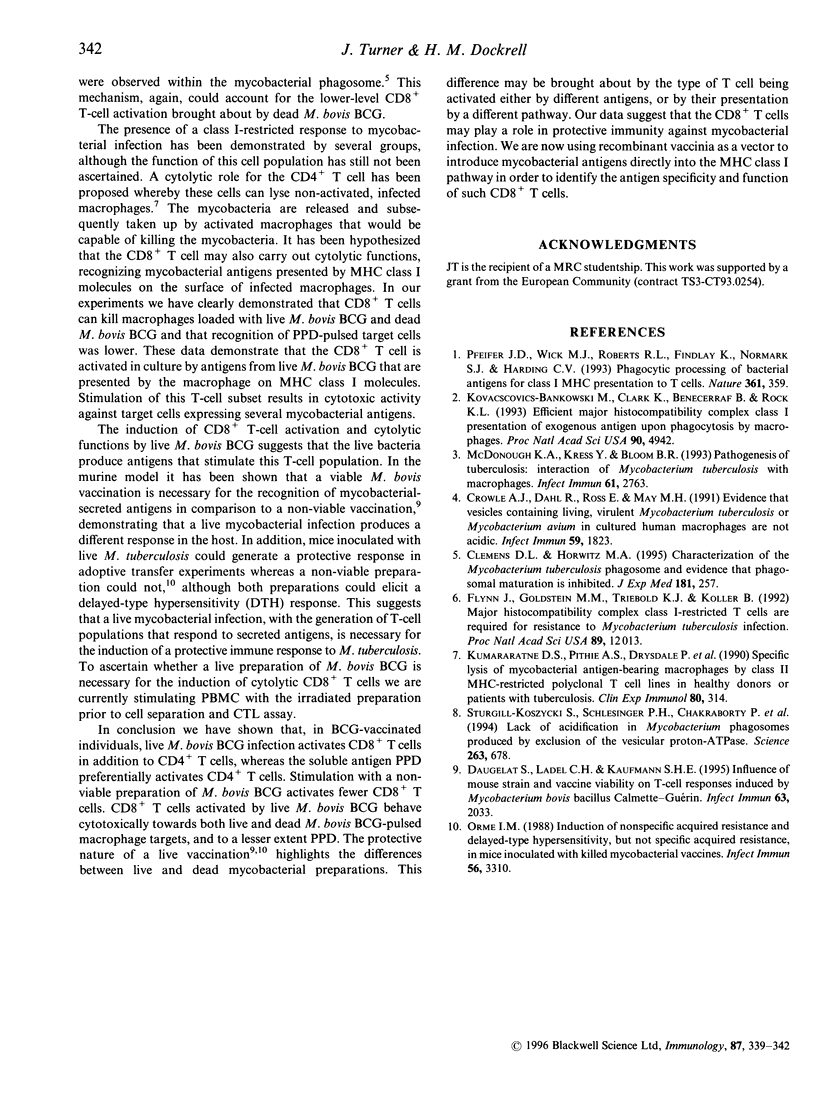Abstract
Experimental data have shown that Mycobacterium tuberculosis can survive within the host cell and in doing so may release secreted antigen into the endogenous antigen-processing pathway. If mycobacterial antigen can gain access to MHC class I molecules then CD8+ T cells may play a role in host defence against M. tuberculosis infection. To identify whether there is a role for the CD8+ T cell in mycobacterial infection we have stimulated peripheral blood mononuclear cells (PBMC) from bacillus Calmette-Guérin (BCG) vaccinated individuals with live M. bovis BCG. The activation state of the T cells was established by staining for the interleukin-2 (IL-2) receptor (CD25), HLA-DR or the transferrin receptor (CD71). Using FACScan analysis we have shown that, in vitro, live M. bovis BCG activates significantly more CD8+ T cells in comparison to the soluble antigen purified protein derivative (PPD). In addition, live M. bovis BCG activates more CD8+ T cells than a non-viable preparation of the same M. bovis BCG following irradiation. The function of the activated CD8+ T cells was addressed using positively selected cells in a cytotoxic T-cell assay. CD8+ T cells isolated from a 7-day M. bovis BCG-stimulated PBMC culture were shown to be cytolytic against target cells infected with live M. bovis BCG, dead M. bovis BCG, and to a lesser extent, PPD. These results suggest that CD8+ T cells may be activated by stimulation with live mycobacteria, and that this subset can play a cytolytic role in the immune response to mycobacterial infections.
Full text
PDF



Selected References
These references are in PubMed. This may not be the complete list of references from this article.
- Clemens D. L., Horwitz M. A. Characterization of the Mycobacterium tuberculosis phagosome and evidence that phagosomal maturation is inhibited. J Exp Med. 1995 Jan 1;181(1):257–270. doi: 10.1084/jem.181.1.257. [DOI] [PMC free article] [PubMed] [Google Scholar]
- Crowle A. J., Dahl R., Ross E., May M. H. Evidence that vesicles containing living, virulent Mycobacterium tuberculosis or Mycobacterium avium in cultured human macrophages are not acidic. Infect Immun. 1991 May;59(5):1823–1831. doi: 10.1128/iai.59.5.1823-1831.1991. [DOI] [PMC free article] [PubMed] [Google Scholar]
- Daugelat S., Ladel C. H., Kaufmann S. H. Influence of mouse strain and vaccine viability on T-cell responses induced by Mycobacterium bovis bacillus Calmette-Guérin. Infect Immun. 1995 May;63(5):2033–2040. doi: 10.1128/iai.63.5.2033-2040.1995. [DOI] [PMC free article] [PubMed] [Google Scholar]
- Flynn J. L., Goldstein M. M., Triebold K. J., Koller B., Bloom B. R. Major histocompatibility complex class I-restricted T cells are required for resistance to Mycobacterium tuberculosis infection. Proc Natl Acad Sci U S A. 1992 Dec 15;89(24):12013–12017. doi: 10.1073/pnas.89.24.12013. [DOI] [PMC free article] [PubMed] [Google Scholar]
- Kovacsovics-Bankowski M., Clark K., Benacerraf B., Rock K. L. Efficient major histocompatibility complex class I presentation of exogenous antigen upon phagocytosis by macrophages. Proc Natl Acad Sci U S A. 1993 Jun 1;90(11):4942–4946. doi: 10.1073/pnas.90.11.4942. [DOI] [PMC free article] [PubMed] [Google Scholar]
- Kumararatne D. S., Pithie A. S., Drysdale P., Gaston J. S., Kiessling R., Iles P. B., Ellis C. J., Innes J., Wise R. Specific lysis of mycobacterial antigen-bearing macrophages by class II MHC-restricted polyclonal T cell lines in healthy donors or patients with tuberculosis. Clin Exp Immunol. 1990 Jun;80(3):314–323. doi: 10.1111/j.1365-2249.1990.tb03287.x. [DOI] [PMC free article] [PubMed] [Google Scholar]
- McDonough K. A., Kress Y., Bloom B. R. Pathogenesis of tuberculosis: interaction of Mycobacterium tuberculosis with macrophages. Infect Immun. 1993 Jul;61(7):2763–2773. doi: 10.1128/iai.61.7.2763-2773.1993. [DOI] [PMC free article] [PubMed] [Google Scholar]
- Orme I. M. Induction of nonspecific acquired resistance and delayed-type hypersensitivity, but not specific acquired resistance in mice inoculated with killed mycobacterial vaccines. Infect Immun. 1988 Dec;56(12):3310–3312. doi: 10.1128/iai.56.12.3310-3312.1988. [DOI] [PMC free article] [PubMed] [Google Scholar]
- Pfeifer J. D., Wick M. J., Roberts R. L., Findlay K., Normark S. J., Harding C. V. Phagocytic processing of bacterial antigens for class I MHC presentation to T cells. Nature. 1993 Jan 28;361(6410):359–362. doi: 10.1038/361359a0. [DOI] [PubMed] [Google Scholar]
- Sturgill-Koszycki S., Schlesinger P. H., Chakraborty P., Haddix P. L., Collins H. L., Fok A. K., Allen R. D., Gluck S. L., Heuser J., Russell D. G. Lack of acidification in Mycobacterium phagosomes produced by exclusion of the vesicular proton-ATPase. Science. 1994 Feb 4;263(5147):678–681. doi: 10.1126/science.8303277. [DOI] [PubMed] [Google Scholar]


